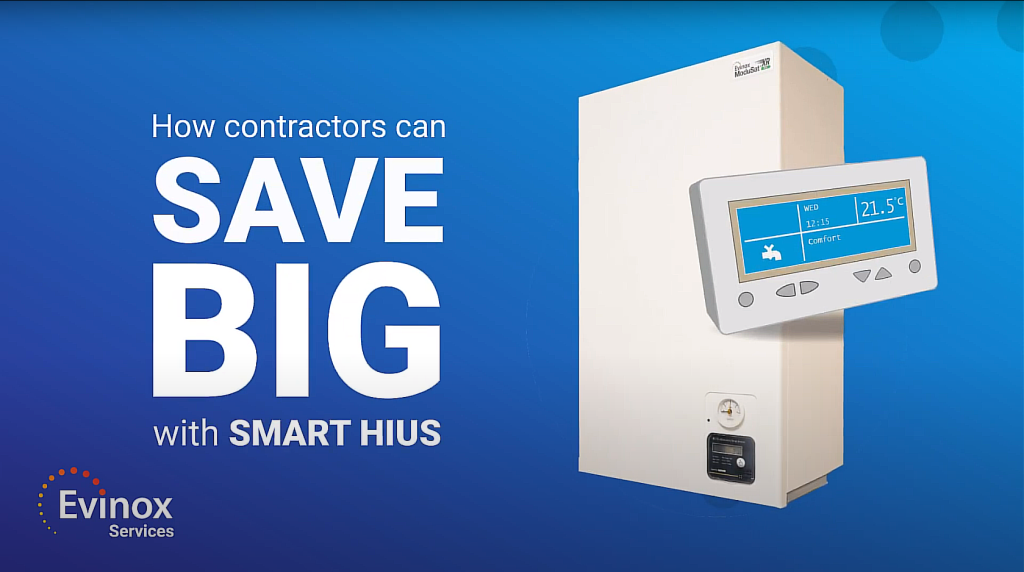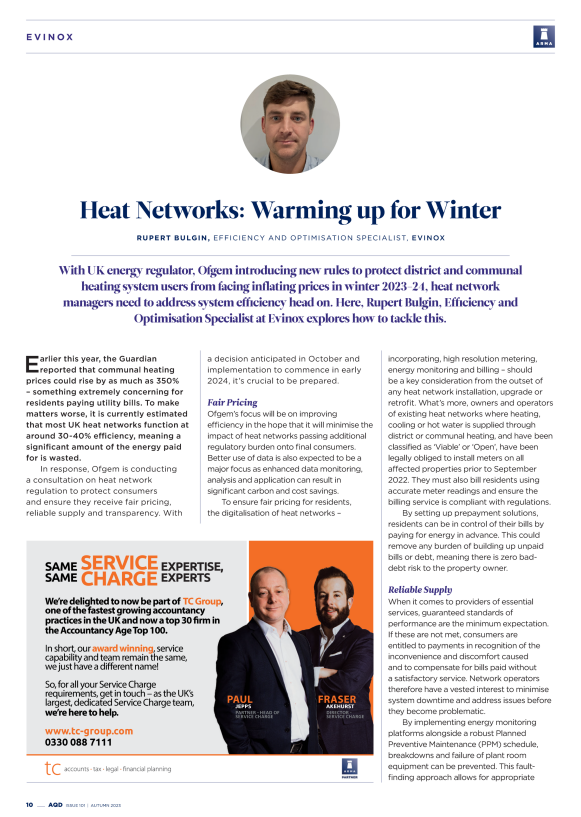As the old saying goes – you can’t have it all. When it comes to heat networks, there is a distinct balancing act between heat network efficiency and hot water response time.
In this blog, Helen Gibbons, Technical and Design Manager at Evinox will discuss the trade-offs between hot water response and efficiency in heat networks.
VWART vs. DHW response
Introduced in 2016, the BESA (British Engineering Services Association) UK Standard for HIUs was launched to help designers and specifiers evaluate the performance of a particular unit on their network. To date, of the 7 electronic units with published test results, a trend can be seen where the HIU achieving the lowest VWART delivers the slowest DHW response time, and vice versa. Most units tested achieve balanced results and end up somewhere in the middle for both tests.
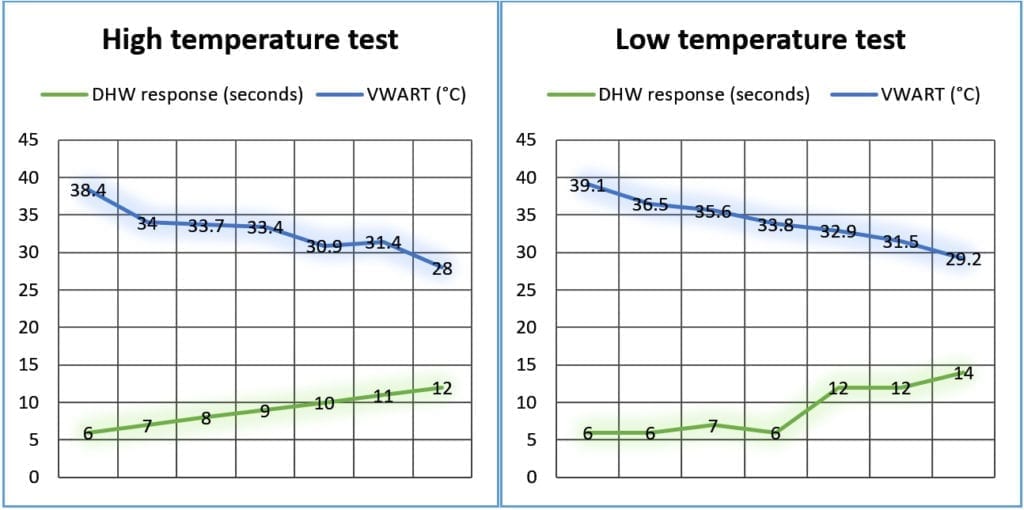
The charts shown above display a VWART figure and DHW response time for each electronically controlled HIU that has been through the BESA test (I haven’t included results for mechanical HIUs as they are not able to control the keep warm functionality). These results clearly show a correlation between a low VWART figure and slow DHW response. HIU manufacturers who have put their unit forward for this test have made a choice – what do we think is more important, VWART or DHW response time?
The manufacturer with the impressive VWART figure of 28.0 °C has achieved this partly by allowing their DHW response time to increase to 12 seconds for the high temperature test (and 14 seconds, close to the required limit of 15, in the low temperature test). At the same time, the manufacturer with the fastest DHW response time, which is 6 seconds, has clearly achieved this at the expense of the VWART – achieving 38.4 °C.
What is keep warm functionality and what role does it play?
One of the key impacts on the overall VWART figure is the use and control of the “Keep Warm” facility, which is designed to keep the hot water plate heat exchanger warm continuously so that the HIU’s can provide a fast response as soon as there is demand for domestic hot water. This function also has the added benefit of keeping the risers and laterals warm, although additional controlled bypass valves are sometimes required, for example at the top of the riser or at the end of laterals.
(Check out my previous blog for more information about Keep-warm)
Whilst the VWART figure clearly reflects the efficiency of the plate heat exchangers and valves used in the unit, it also shows that improvements can be made by adjusting the keep warm strategy and allowing the DHW response time to increase. It’s obvious when you think about it, if less power is used to keep the plates warm, it will then take longer to receive hot water.
With the new generation of electronically controlled smart HIUs on the market, which feature self-learning, there are a number of settings that can be put in place for the keep-warm functionality, to help provide a fast DHW response with a low VWART. Take our ModuSat XR as an example, the self-learning functionality means the unit can learn what time you get up every morning and make the plate hot and ready for you by that time. Even if this might not show in BESA test results, in real life terms this will further reduce the return temperature.
Additionally, with a Smart HIU the network operator is able to decide the best solution for their specific network and make adjustments to the settings remotely. Is it DHW response time for the residents or the overall efficiency of the heat network or an agreed compromise for both?
Legionella and DHW response
But by how much can you delay the DHW response time without getting into bother? Is the DHW response time a question of convenience and comfort, or are there other aspects at play?
These questions go hand in hand with what I discussed in my previous blog post about timing the keep warm function, where a large energy saving can be made if the system is designed in a way which lets the keep warm function switch off during parts of the day.
One of the arguments out there against a delayed DHW response time, is the possibility of the hot water taking longer than 60 seconds to reach the outlets. The Hot Water Association even goes as far in their Design Guide for Stored Water Solutions [1] as to boldly state that the keep warm function is required for twin plate HIUs to meet requirements of legionella and water regulations, which is simply not true.
This all stems from HSE’s advice on Legionnaires disease, where in HSG274 Part 2 it states that the traditional strategy for reducing risk of legionnaire’s disease, is to store water at 60°C or above, and for this water to be distributed so that it reaches the outlet at 50°C within one minute. It is important to note that the same document classes instantaneous heaters as low-risk systems.
The same advice is replicated in BSRIA’s Legionnaires disease O&M log book, which suggests that hot water should reach 50°C within one minute, but class instantaneous water heaters as an alternative system presenting minimum risk from legionella.
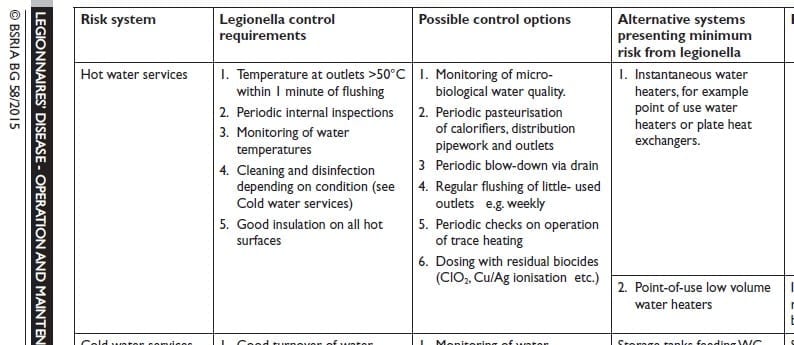
This advice is replicated in a number of other documents, all referencing back to HSE 274 Part 2.
The above table from BSRIA makes it clear that the “50°C within 60 seconds” school of thought stem from advice based on stored water, but as there is next to no stored water in a twin plate HIU, the risk of legionella is minimised.
We also have the well-respected German Standard DVGW W 551 (Drinking water heating and drinking water piping systems; technical measures to reduce Legionella growth) which states that if controlled properly, a system with a total volume (from hot water production to end use) of less than 3 litres can eliminate the risk of Legionella.
Standards and regulations aside, is there actually a risk of legionella if the DHW takes longer than 1 minute to reach the outlet? From what I have found there is and there isn’t, but the DHW temperature set point at the HIU makes no odds.
At 60°C, it takes 25 minutes to kill the legionella bacteria [1]. If we take this information and think about cold water being heated up to 50°C in the plate heat exchanger of the HIU. The water will be heated for a fraction of a second, nowhere near enough time to kill any of the bacteria present in the water.
This is backed up by the following graph illustrating how long it takes to decrease or increase the growth of legionella bacteria at different temperatures [2]:
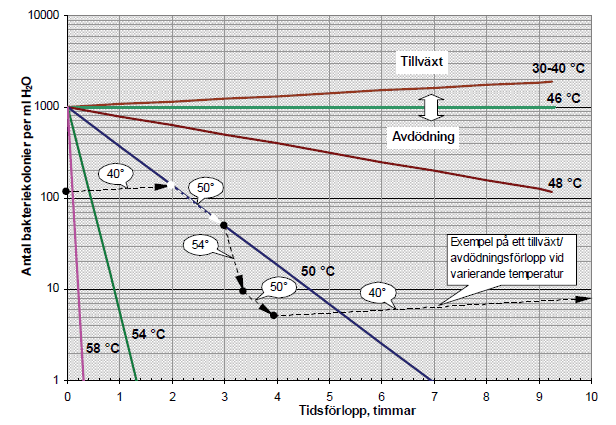
The y-axis is showing the number of bacteria colonies per ml H2O and the x-axis is showing hours lapsed. This graph shows that after one hour at 50°C, the bacteria has reduced by 60%, but that during the small amount of time the water is heated to 50°C in the PHE, the level of bacteria is unaffected.
What about if the water is heated to 50°C and kept at 50°C during the one minute it takes for it to get to the tap? Nope, it still doesn’t look like one minute at 50°C will be able to kill much of the bacteria that would potentially be present in the water.
The conclusions I draw from this information are that getting the water to the tap at 50°C within 1 minute has no effect on the legionella risk when it comes to instantaneous twin plate HIUs. The risk is where the water is stored, ie. in the cold water booster tank and the cold water distribution pipework. This is where there is a risk of the legionella bacteria multiplying if the temperature of the cold water is too high, and if the bacteria has been given the chance to grow in the cold water pipework. Heating it to 50°C or even 60°C in an instantaneous water heater will not kill it or even noticeably reduce the levels.
Despite this information, I can still understand if system designers would like to stick to the 50°C within 1 minute rule in the absence of any firm advice regarding instantaneous heaters. Even BS 8558:2015 quotes the 50°C within one minute rule, but again references back to HSG274 Part 2. A discussion needs to be had with HSE to see if this piece of advice can be rewritten to clarify that this rule should not apply to instantaneous heaters.
If legislation stipulates a high DHW temperature with a very fast DHW response time, this will lead to the continuation of unnecessarily oversizing heat networks under a false pretence that this somehow protects the end user from contracting Legionnaire’s disease.
There is of course still the comfort argument to be had, but that’s for another day.
Hot water return and heat network efficiency
In line with the above, we often see projects where a specific domestic hot water return temperature is detailed in the specification for instantaneous twin plate HIU’s. When we see this, it is important to have a discussion with the client to understand the reasons behind the required temperature and explain how this might affect the heat network efficiencies.
As with the keep warm facility, the DHW return will increase convenience for the resident but will come at an expense of the heat network. The return temperature of the primaries cannot physically be lower than what they are cooling down against, and if they are constantly cooling down against a hot water return of 50°C, the primary return will always be above 50°C in this mode.
The above will also mean that the HIU will constantly be bypassing primary water, so both the total volume of water, as well as return temperature, will increase.
Alternative designs that offer a happy medium
When I said earlier that you can’t have it all – this is of course not true. There are a couple of ways in which you can have a fast DHW response time which will not come at the expense of the heat network efficiency. Solutions we recommend include the following;
- Trace heating of the hot water pipework. If a trace heating cable is placed on the pipework underneath any lagging, you will still get the fast delivery of hot water. And as the trace heating is only used to maintain the temperature of the water in the pipe, rather than heating it up from cold, the energy consumption from applying this is low.
- Reduce the size of your hot water pipework. Let’s say the pipework required from the HIU to your hot water outlet is 6 meters. If you use 22mm copper to deliver this water, and the required hot water flow rate is 0.10 l/s, the velocity within the pipework will be approximately 0.31 m/s and it will take the water almost 20 seconds to get to the outlet. Reduce the pipework dimension to 15mm and the delivery time is more than halved to 9 seconds. And if you are able to use 10mm pipework the velocity increase to 1.64 m/s with a delivery time of only 4 seconds! This means that even if the HIU takes 55 seconds to get the hot water up to 50°C, you are still within the golden minute.
If this is not possible, an alternative to using small dimension pipework is to install a potable water manifold at the HIU, and to have a single pipe serving each outlet.
Conclusion
In almost all cases – fast hot water response time will come at the expense of the heat network efficiency. As an industry, it should be our priority to make these networks as efficient as possible to avoid getting negative press and secure the position of heat networks in the UK infrastructure. It is the price per kWh and the carbon emissions that will get measured at the end of the day – not how long people have to wait to have a shower, especially not when it is a question of seconds.
In high end developments, where comfort and convenience are especially critical, the alternative design solutions should be used, i.e. trace heating or small-bore pipework. As long as there are ways around this, let’s allow our systems and HIU’s to perform as efficiently as possible.
But most importantly of all, let the operator of the heat network decide what they want to do, after all, they will know their system and residents better than any of us. Is efficiency and cost important? Is fast hot water response important? As long as we give the operator the information and benefits of different options, why not let them decide? With a smart-HIU they can even try different options out over time, until they find the ultimate strategy for their building.
Heat Networks: Warming up for Winter
 Jake Molley
Jake Molley
 23rd October 2023
23rd October 2023

